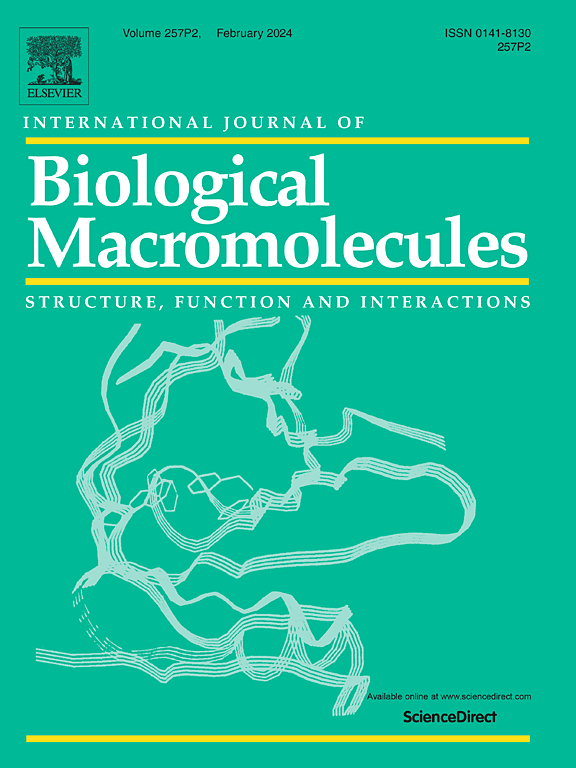Preparation and in vitro biological studies of photothermal response ginsenoside CK-carboxymethyl chitosan-based prodrug nanomicelles for synergistic therapy
IF 8.5
1区 化学
Q1 BIOCHEMISTRY & MOLECULAR BIOLOGY
International Journal of Biological Macromolecules
Pub Date : 2025-06-01
DOI:10.1016/j.ijbiomac.2025.144747
引用次数: 0
Abstract
This study develops a photothermal-chemotherapy nanoplatform based on IR820/ ginsenoside compound K (CK) prodrug nanomicelles, fabricated via ultrasonic self-assembly of O-carboxymethyl chitosan (OCMC), N-isopropylacrylamide, and thermoresponsive IR820. The water solubility of carboxylated CK and its OCMC grafted polymer (OCMC-CK) demonstrated remarkable enhancements, showing 4.14-fold and 26.69-fold, respectively, compared with Free CK. Significant improvement in solubility correlates with the observed enhancement in cytotoxicity against HepG-2 cells for both CK-COOH and OCMC-CK. The synthesized nanoparticle exhibited an average particle size of 213.9 ± 4.8 nm, a zeta potential of −24.7 ± 2.1 mV, and a minimum critical micelle concentration of 0.062 mg/mL. Additionally, these prodrug nanomicelles demonstrated near infrared (NIR) radiation responsive, enabling the generation of singlet oxygen (1O2) and subsequent CK release upon NIR irradiation. In vitro photothermal tests revealed that approximately 85.23 % of CK was released within in 10 h. Remarkably, the cell survival rate only 9.34 % at a CK concentration of 25 μg/mL under NIR irradiation in vitro. Collectively, the cytotoxicity experiments revealed that synthetic precursor nanomicelles exerted a significant inhibitory effect on HepG-2 cells survival via photo-response release of CK and IR820, enabling synergistic photothermal/chemotherapy while enhancing both water solubility and bioavailability of carboxylated ginsenoside CK.
基于人参皂苷ck -羧甲基壳聚糖的光热反应前药纳米胶束的制备及体外生物学研究
本研究通过超声波自组装o -羧甲基壳聚糖(OCMC)、n -异丙基丙烯酰胺和热响应性IR820制备了一种基于IR820/人参皂苷化合物K (CK)前药纳米束的光热化疗纳米平台。羧基化CK及其OCMC接枝聚合物(OCMC-CK)的水溶性显著提高,分别是游离CK的4.14倍和26.69倍。CK-COOH和OCMC-CK的溶解度显著改善与对HepG-2细胞的细胞毒性增强有关。合成的纳米粒子平均粒径为213.9±4.8 nm, zeta电位为- 24.7±2.1 mV,最小临界胶束浓度为0.062 mg/mL。此外,这些药物前纳米胶束表现出近红外(NIR)辐射响应,使单线态氧(1O2)的产生和随后的CK在近红外辐射下释放。体外光热实验表明,10 h内CK释放量约为85.23%,在近红外辐照下,CK浓度为25 μg/mL时,细胞存活率仅为9.34%。总的来说,细胞毒性实验表明,合成的前体纳米胶束通过CK和IR820的光响应释放对HepG-2细胞的存活有显著的抑制作用,实现光热/化疗协同作用,同时提高羧化人参皂苷CK的水溶性和生物利用度。
本文章由计算机程序翻译,如有差异,请以英文原文为准。
求助全文
约1分钟内获得全文
求助全文
来源期刊
CiteScore
13.70
自引率
9.80%
发文量
2728
审稿时长
64 days
期刊介绍:
The International Journal of Biological Macromolecules is a well-established international journal dedicated to research on the chemical and biological aspects of natural macromolecules. Focusing on proteins, macromolecular carbohydrates, glycoproteins, proteoglycans, lignins, biological poly-acids, and nucleic acids, the journal presents the latest findings in molecular structure, properties, biological activities, interactions, modifications, and functional properties. Papers must offer new and novel insights, encompassing related model systems, structural conformational studies, theoretical developments, and analytical techniques. Each paper is required to primarily focus on at least one named biological macromolecule, reflected in the title, abstract, and text.

 求助内容:
求助内容: 应助结果提醒方式:
应助结果提醒方式:


